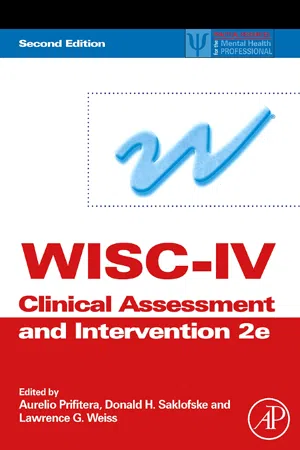
WISC-IV Clinical Assessment and Intervention
- 600 pages
- English
- ePUB (mobile friendly)
- Available on iOS & Android
WISC-IV Clinical Assessment and Intervention
About This Book
The Wechsler Intelligence Scale for Children: Fourth Edition (WISC-IV) is one of the most often used measures to assess intelligence and cognitive functions in children, ages 6-16 years. The second edition of the WISC-IV Clinical Assessment and Intervention will include new information obtained from the clinical use of the WISC-IV in practice. Information on the basic use of the assessment tool is condensed from three chapters into one, with four new chapters discussing how to use and interpret WISC-IV with additional clinical populations. These new populations include pervasive Developmental Disorders including autism, Social and emotional disorders, psychiatric disorders, and medical disorders that may affect intelligence. An additional new chapter discusses intervention planning across patient populations. Each of the chapters (revised original chapters and new chapters) will additionally include case studies including diagnosis and intervention.Overall, the material in the book is 65% changed, new, and updated. These changes make the second edition better able to meet a clinician's needs in using and interpreting this test.
- Inclusion of case studies illustrating the clinical applications of the WISC-IV in assessment and program planning
- Intervention recommendations following from assessment to diagnosis
- Introductory chapter illustrating the relationships between the WISC-IV index scores and intervention planning
- New chapters on Learning Disabilities, emotionally disturbed children, systematic illness, and Autism Spectrum Disorders
- Specialized chapters on neuropsychological applications, executive functioning, and cultural issues
- Additional information to aid test interpretation including extended norms for gifted children and the Cognitive Proficiency Index
- All chapters revised to reflect data obtained from the test in clinical use
Frequently asked questions
Information
Table of contents
- Brief Table of Contents
- Table of Contents
- Dedication
- List of Contributors
- Preface
- Part I. Interfacing WISC-IV Assessment and Intervention: Foundations for Practice
- Part II. Interfacing WISC-IV Assessment and Intervention: Clinical Applications
- Part III. Interfacing WISC-IV Assessment and Intervention: Some Further Considerations